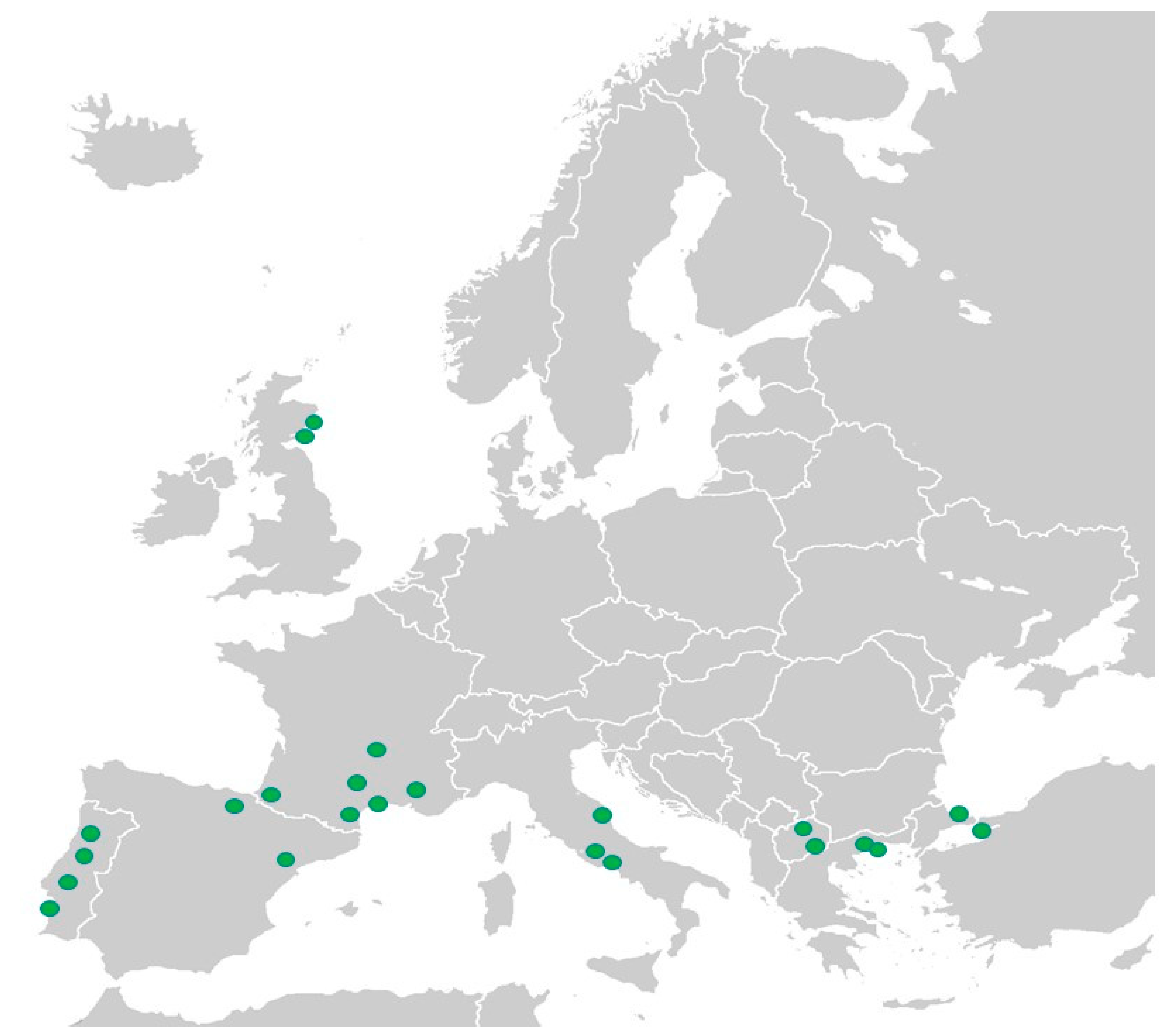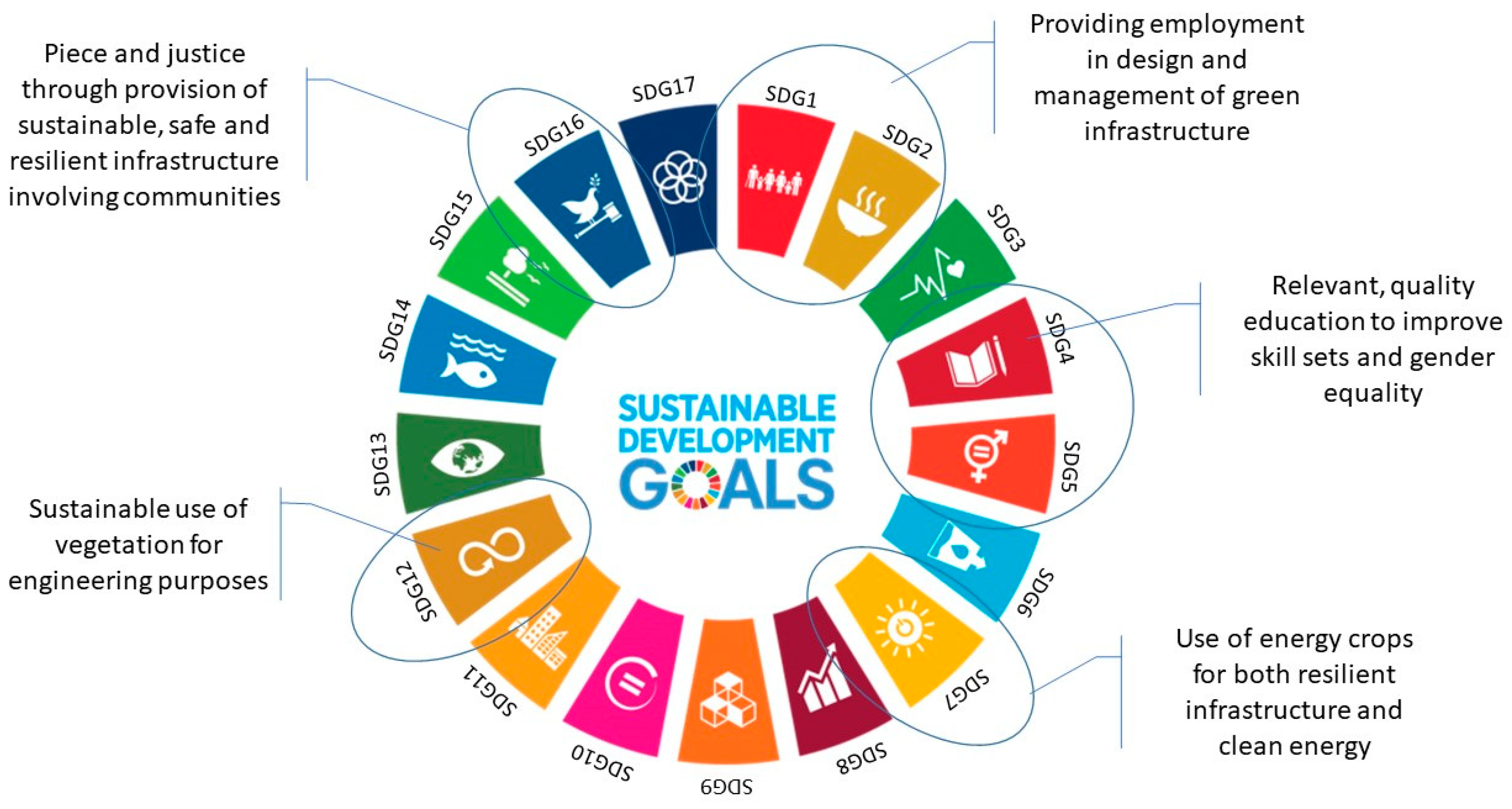Re-Thinking Soil Bioengineering to Address Climate Change Challenges
Abstract
:1. Introduction
2. Materials and Methods
3. Results
4. Discussion
4.1. Sustainable Soil Bioengineering Project Management
4.2. Sustainable Soil Bioengineering Design
4.3. Sustainable Soil Bioengineering Construction and Operation
4.4. Soil Bioengineering Education
4.5. Soil Bioengineering for Achievement of the Other UN SDGs
5. Conclusions
Funding
Institutional Review Board Statement
Informed Consent Statement
Data Availability Statement
Acknowledgments
Conflicts of Interest
References
- Adshead, D.; Thacker, S.; Fuldauer, L.I.; Hall, J.W. Delivering on the Sustainable Development Goals through long-term infrastructure planning. Glob. Environ. Chang. 2019, 59, 101975. [Google Scholar] [CrossRef]
- Deloitte. New Technologies Case Study: Data Sharing in Infrastructure—A Final Report for the National Infrastructure Commission; Deloitte LLP: London, UK, 2017; 50p. [Google Scholar]
- Gonzalez-Ollauri, A.; Mickovski, S.B. Providing ecosystem services in a challenging environment by dealing with bundles, trade-offs, and synergies. Ecosyst. Serv. 2017, 28, 262–263. [Google Scholar] [CrossRef] [Green Version]
- Gonzalez-Ollauri, A.; Mickovski, S.B. Plant-Best: A novel plant selection tool for slope protection. Ecol. Eng. 2017, 106, 154–173. [Google Scholar] [CrossRef] [Green Version]
- Kumar, P.; Debele, S.E.; Sahani, J.; Aragão, L.; Barisani, F.; Basu, B.; Bucchignani, E.; Charizopoulos, N.; Di Sabatino, S.; Domeneghetti, A.; et al. Towards an operationalisation of nature-based solutions for natural hazards. Sci. Total Environ. 2020, 731, 138855. [Google Scholar] [CrossRef] [PubMed]
- European Commission. Green Infrastructure (GI)—Enhancing Europe’s Natural Capital. In Communication from the Commission to the European Parliament, the Council, the European Economic and Social Committee and the Committee of the Regions; Document 52013DC0249; European Commission: Brussels, Belgium, 2013. [Google Scholar]
- European Commission. Review of progress on implementation of the EU green infrastructure strategy. In Report from the Commission to the European Parliament, the Council, the European Economic and Social Committee and the Committee of the Regions; COM (2019) 236 Final; European Commission: Brussels, Belgium, 2019. [Google Scholar]
- Norris, J.E.; Stokes, A.; Mickovski, S.B.; Cammeraat, E.; van Beek, R.; Nicoll, B.C.; Achim, A. Slope Stability and Erosion Control: Ecotechnological Solutions; Hardcover; Springer: Dordrecht, Germany, 2008; 290p. [Google Scholar]
- Rey, F.; Bifulco, C.; Bischetti, G.B.; Bourrier, F.; De Cesare, G.; Florineth, F.; Graf, F.; Marden, M.; Mickovski, S.B.; Phillips, C.; et al. Soil and water bioengineering: Practice and research needs for reconciling natural hazard control and ecological restoration. Sci. Total Environ. 2018, 648, 1210–1218. [Google Scholar] [CrossRef] [PubMed]
- Coppin, N.J.; Richards, I.G. Use of Vegetation in Civil Engineering; CIRIA C708; CIRIA: London, UK, 2007. [Google Scholar]
- Stokes, A.; Douglas, G.B.; Fourcaud, T.; Giadrossich, F.; Gillies, C.; Hubble, T.; Kim, J.H.; Loades, K.W.; Mao, Z.; McIvor, I.R.; et al. Ecological mitigation of hillslope instability: Ten key issues facing researchers and practitioners. Plant Soil 2014, 377, 1–23. [Google Scholar] [CrossRef] [Green Version]
- Fernandes, J.P.; Guiomar, N. Nature-based solutions: The need to increase the knowledge on their potentialities and limits. Land Degrad. Dev. 2018, 29, 1925–1939. [Google Scholar] [CrossRef]
- Mickovski, S.; Thomson, C. Developing a framework for the sustainability assessment of eco-engineering measures. Ecol. Eng. 2017, 109, 145–160. [Google Scholar] [CrossRef] [Green Version]
- Tardio, G.; Mickovski, S.B. Implementation of eco-engineering design into existing slope stability design practices. Ecol. Eng. 2016, 92, 138–147. [Google Scholar] [CrossRef]
- Schiechtl, H.M.; Stern, R. Soil Bioengineering Techniques for Slope Protection and Erosion Control; Blackwell Science: London, UK, 1996; 367p. [Google Scholar]
- Debele, S.E.; Kumar, P.; Sahani, J.; Marti-Cardona, B.; Mickovski, S.B.; Leo, L.S.; Porcù, F.; Bertini, F.; Montesi, D.; Vojinovic, Z.; et al. Nature-based solutions for hydro-meteorological hazards: Revised concepts, classification schemes and databases. Environ. Res. 2019, 179, 108799. [Google Scholar] [CrossRef] [PubMed]
- Garcia Rodriguez, J.L.; Sangalli, P.; Tardio, G.; Mickovski, S.; Fernandes, J.P.; Gimenez, M.C. (Eds.) Specialization Process for the Bioengineering Sector in the Mediterranean Environment. Ecomed Project Part II. Protocols and Case Studies; Technical University of Madrid: Madrid, Spain, 2019; 462p, ISBN 9788496442894. [Google Scholar]
- Tardio, G.; Mickovski, S.B. Method for synchronisation of soil and root behaviour for assessment of stability of vegetated slopes. Ecol. Eng. 2015, 82, 222–230. [Google Scholar] [CrossRef] [Green Version]
- British Standards Institution (BSI). BS 8536-2:2016: Briefing for Design and Construction. Code of Practice for Asset Management (Linear and Geographical Infrastructure); BSI: London, UK, 2016. [Google Scholar]
- Centre for Digital Built Britain (CDBB). The Gemini Principles: Guiding Values for the National Digital Twin and Information Management Framework; Centre for Digital Built Britain and Digital Framework Task Group: West Cambridge, UK, 2018. [Google Scholar]
- Garcia Rodriguez, J.L.; Sangalli, P.; Tardio, G.; Mickovski, S.; Fernandes, J.P.; Gimenez, M.C. (Eds.) Specialization Process for the Bioengineering Sector in the Mediterranean Environment. Ecomed Project Part I. Training Modules; Technical University of Madrid: Madrid, Spain, 2019; 568p, ISBN 9788496442887. [Google Scholar]
- MacIver, R.T.; Mickovski, S.B. Renewable energy potential of roadside grass cuttings. In Proceedings of the 2nd International Conference on Energy, Environment and Economics (ICEEE 2017), Edinburgh, UK, 11 December 2017; Agarwal, A., Singh, R., Eds.; Volume 5, pp. 122–128. [Google Scholar]
- Lucherini, A.; Gonzalez-Ollauri, A.; Mickovski, S.B. The Effect of Vegetation on Soil Polluted with Galligu: Phytostabilisation and Novel Approaches to Evaluate Soil Galligu Concentration. Environ. Geotech. 2020, 1–15. [Google Scholar] [CrossRef]





| Case Study Short Description | Environment | Location | Country | Feasibility | Design | Award | Mobilisation | Construction | Demobilisation | Monitoring | Long Term | UN SDGs Considered |
|---|---|---|---|---|---|---|---|---|---|---|---|---|
| National park | Slope | Gaeta | Italy | low vegetation cover | 3,8,9,11,13,15,16,17 | |||||||
| Riverbank | Slope | Melfa | Italy | no maintenance contract | design change during construction | monitoring site visit every 6 months | 3,9,11,13,15, 17 | |||||
| River channel | Fluvial | Baztan | France | climate change resilience based on hydrology report | relatively long period between design and construction | well qualified workforce used | 3,6,9,11,13,15,17 | |||||
| Riverbank | Fluvial | Garonne | France | wide range of stakeholders involved | design based on ecological/ social/ technical report | lack of qualified workforce | 3,6,9,11,13,15,17 | |||||
| Riverbank | Fluvial | Longes Aygues | France | no geotechnical report | partial failure of the constructed measure | 3,6,9,11,13,15, 17 | ||||||
| Riverbank | Fluvial | Arize | France | no maintenance contract | incrwase in erosion due to trampling | 3,6,9,11,13,15,17 | ||||||
| Riverbank | Fluvial | Hers | France | no maintenance contract | no monitoring contract | soil creep and erosion in long term | 3,6,9,11,13,15,17 | |||||
| River channel | Fluvial | Artia | Spain | adjacent land and land use pose future risks | 3,6,9,11,13,14,15,17 | |||||||
| Roadside slope | Slope | Ripe | Italy | low vegetation cover immediately after construction | local plant species affectd by climate change | 3,8,9,10,11,13,17 | ||||||
| Torrent catchment | Slope | Thasos | Greece | prescriptive design only; no field testing/measurements | no maintenance contract | no monitoring | adjacent land poses future risks; GIS should be used | 3,9,11,13,17 | ||||
| Marble quarry restoration | Slope | Drama | Greece | no maintenance contract | manual seeding/planting only resulting in low cover | no monitoring | low plant density | 3,8,9,11,13,15,17 | ||||
| Motorway cutting | Slope | Nogaevci | Macedonia | limited funding | works not fully implemented | no monitoring | 3,8,9,10,11,13,17 | |||||
| Motorway cutting | Slope | Gevgelija | Macedonia | limited funding | works not fully implemented | no monitoring | washout/erosion | 3,8,9,10,11,13,17 | ||||
| Infrastructure cutting | Slope | Kartaltepe | Turkey | no/limited monitoring contract | 3,8,9,10,11,13,17 | |||||||
| Riverbank | Fluvial | Couros | Portugal | prescriptive design; no investigation | no maintenance contract | lack of qualified workforce | no quality control | no monitoring | slope failures and erosion after construction | 3,6,9,11,13,15,17 | ||
| Natural roadside slope | Slope | Albergaria | Portugal | prescriptive design; no investigation | no maintenance contract | lack of qualified workforce | no monitoring | 3,8,9,10,11,13,15,17 | ||||
| Riverbank | Fluvial | Argoncilhe | Portugal | prescriptive design; no investigation | no maintenance contract | lack of qualified workforce | no monitoring | slope failures and erosion after construction | 3,6,9,11,13,14,15,17 | |||
| Beach dunes | Coastal | Guincho | Portugal | prescriptive design; no investigation | no maintenance contract | lack of qualified workforce | no monitoring | 3,9,11,13,14,15,17 | ||||
| Coastal slope in a bay | Coastal | Stonehaven | Scotland | lack of qualified workforce | groundwater monitoring only | adjacent land and land use pose risks | 3,9,11,13,15, 17 | |||||
| Coastal slope in a bay | Coastal | Catterline | Scotland | specified inspection and limited monitoring | adjacent land and land use pose risks | 3,9,11,13,15, 17 | ||||||
| Riverbank | Fluvial | Tenes | Spain | prescriptive design; no calculations; local standards used | qualified personnel mobilised early | 3,6,9,11,13,14,15, 17 | ||||||
| Beach dunes | Coastal | Terkos | Turkey | no engineering plan of works | no maintenance contract | ocassional monitoring | 3,9,11,13,17 | |||||
| River estuary waterfront | Fluvial | Alverca | Portugal | prescriptive design; no investigation | no maintenance contract | lack of qualified workforce | no quality control | no monitoring | slope failures and erosion afterc onstruction | 3,6,9,11,13,15,17 | ||
Publisher’s Note: MDPI stays neutral with regard to jurisdictional claims in published maps and institutional affiliations. |
© 2021 by the author. Licensee MDPI, Basel, Switzerland. This article is an open access article distributed under the terms and conditions of the Creative Commons Attribution (CC BY) license (http://creativecommons.org/licenses/by/4.0/).
Share and Cite
Mickovski, S.B. Re-Thinking Soil Bioengineering to Address Climate Change Challenges. Sustainability 2021, 13, 3338. https://doi.org/10.3390/su13063338
Mickovski SB. Re-Thinking Soil Bioengineering to Address Climate Change Challenges. Sustainability. 2021; 13(6):3338. https://doi.org/10.3390/su13063338
Chicago/Turabian StyleMickovski, Slobodan B. 2021. "Re-Thinking Soil Bioengineering to Address Climate Change Challenges" Sustainability 13, no. 6: 3338. https://doi.org/10.3390/su13063338






